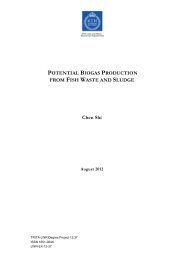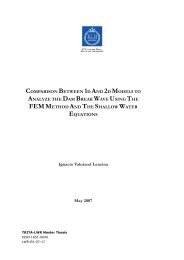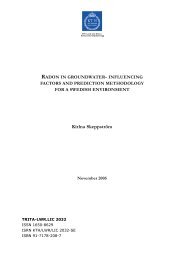Water <strong>sources</strong>, <strong>infrastructure</strong>, <strong>space</strong> <strong>and</strong> <strong>the</strong> <strong>dynamics</strong> <strong>of</strong> environmental diseases in Saboba District: Using GISconsiderable increase in <strong>water</strong> related diseases such as Typhoid. This hasfur<strong>the</strong>r deepened <strong>the</strong> poverty levels <strong>of</strong> <strong>the</strong> people, especially women in<strong>the</strong> district. Pervasive poverty in turn forces people to make desperatechoices with regards to <strong>the</strong> use <strong>of</strong> <strong>the</strong>ir environment such as free-rangedefecation, waste dumping etc. These choices frequently increase <strong>the</strong>ir<strong>water</strong> related health risks.Management <strong>of</strong> <strong>water</strong> re<strong>sources</strong>: <strong>the</strong> past <strong>and</strong> <strong>the</strong> present comparedTable 8 shows various customary (CL) <strong>and</strong> government/district lawswith <strong>the</strong> aim <strong>of</strong> protecting <strong>water</strong> re<strong>sources</strong> in <strong>the</strong> district. Both legalsystems largely use punitive system <strong>of</strong> managing <strong>and</strong> protecting <strong>water</strong>bodies. A glance at <strong>the</strong> table shows that customary laws protected <strong>water</strong>re<strong>sources</strong> in its entirety than government laws. For example, 8.1% (7) <strong>of</strong>respondents mention do not cut trees along rivers or <strong>water</strong> bodies while nonemention that for government/district laws. The reasons for suchrestrictions are; 1) to prevent river bank erosion <strong>and</strong> siltation, <strong>and</strong> 2) toprevent farming <strong>and</strong> use <strong>of</strong> fertiliser very close to <strong>sources</strong> <strong>of</strong> drinking<strong>water</strong>.Management <strong>of</strong> <strong>water</strong>: effectiveness <strong>of</strong> customary <strong>and</strong> district systemsFigure 5 shows that more than a third (41.8%) <strong>of</strong> <strong>the</strong> respondents saidthat <strong>the</strong> customary laws were highly effective, 36.1% (medium), while22.1% said its effectiveness was low. However, a reverse is <strong>the</strong> case forgovernment/district laws in protecting <strong>water</strong> re<strong>sources</strong>. Close to half(49.5%) <strong>of</strong> <strong>the</strong> respondents believe <strong>the</strong> effectiveness was low, 44%(medium), while only 6.5% said it was highly effective. This low ratingfor government/district laws is due to four reasons; 1) lack <strong>of</strong> effective<strong>water</strong> policy <strong>and</strong> low implementation <strong>of</strong> government machinery, 2) <strong>the</strong>fact that <strong>the</strong> government laws are made top-down, unlike customary lawswhich came from <strong>the</strong> people by <strong>the</strong> people <strong>and</strong> for <strong>the</strong> people, 3) due to socialallegiance <strong>and</strong> instant punishment meted out to <strong>of</strong>fenders, people weremore likely to obey customary laws, <strong>and</strong> 4) Umoadanbor ownership <strong>of</strong> <strong>the</strong><strong>water</strong> re<strong>sources</strong> was on small territories <strong>and</strong> easily monitored than largeterritorial boundaries <strong>of</strong> <strong>the</strong> district. This gives credence to fur<strong>the</strong>rdecentralisation <strong>of</strong> <strong>water</strong> management policies.Sources <strong>of</strong> <strong>water</strong> in <strong>the</strong> selected areasThe <strong>sources</strong> <strong>of</strong> <strong>water</strong> for some selected areas in <strong>the</strong> district are presentedin this section. I selected Saboba Town, Bordagbalm <strong>and</strong> Wapuli because<strong>of</strong> <strong>the</strong> variations that exist between <strong>the</strong> areas, <strong>and</strong> also due to <strong>the</strong> factthat <strong>the</strong>se were <strong>the</strong> chosen areas for administration <strong>of</strong> questionnaires.Saboba TownSaboba town consists <strong>of</strong> about 15–20% <strong>of</strong> <strong>the</strong> district’s population. If<strong>the</strong> surrounding villages are added, <strong>the</strong> proportion will even be greater.The main source <strong>of</strong> <strong>water</strong> in <strong>the</strong> town before mid-1990 was mainly from<strong>the</strong> Moadani dam located some few metres to Umoadanbor-do (River-Chief’s Home) <strong>and</strong> wells. The town used to have only 3 boreholes – oneeach at SABTECH, Moadani <strong>and</strong> Chief-section. However, <strong>the</strong> ones atSABTECH <strong>and</strong> Moadani have been out <strong>of</strong> operation over 10 years agodue to lack <strong>of</strong> maintenance. Two new boreholes have been added atMoadani recently, <strong>of</strong> which <strong>water</strong> from one <strong>of</strong> <strong>the</strong>m already have badscent. To avoid being seen as bias, <strong>the</strong> NGOs usually site <strong>the</strong> boreholesfar<strong>the</strong>r away from any <strong>of</strong> <strong>the</strong> organised communities, since <strong>the</strong>y cannotprovide all <strong>of</strong> <strong>the</strong>m with boreholes. As a result, many <strong>of</strong> <strong>the</strong> boreholesare sited at far<strong>the</strong>r distance from users, which are usually inaccessibleduring rainy seasons when <strong>water</strong> ga<strong>the</strong>rs <strong>the</strong> intervening culverts, streams<strong>and</strong> valleys. Many <strong>of</strong> <strong>the</strong> inhabitants do not use <strong>the</strong> borehole <strong>water</strong>21
Mat<strong>the</strong>w Biniyam KursahTRITA LWR Master Thesisbecause <strong>of</strong> distance or as <strong>the</strong>y say it is too light <strong>and</strong> does not quench thirst.Currently, <strong>the</strong> pipe <strong>water</strong> supplied by <strong>the</strong> Saboba Community WaterPlant is <strong>the</strong> main source <strong>of</strong> drinking <strong>water</strong> for <strong>the</strong> town. The <strong>water</strong> plantis operating beyond its carrying capacity, <strong>and</strong> political influences <strong>and</strong>dictates (extension for political gains) <strong>and</strong> poor maintenance lead tooverstress, resulting in its frequent breakdown. Lack <strong>of</strong> funds topurchase chemicals for treating <strong>water</strong>, has necessitated <strong>the</strong> pumping <strong>of</strong>untreated <strong>water</strong> to residents. With only 400 pipes in <strong>the</strong> town for over15,000 people, <strong>of</strong> which about 100 have already been disconnected, havefur<strong>the</strong>r complicated <strong>the</strong> <strong>water</strong> problem in Saboba town <strong>and</strong> its environs(Box 2). The Moadani dam, wells <strong>and</strong> dugout pits still serve as major<strong>water</strong> supply to <strong>the</strong> people <strong>of</strong> Saboba town, especially duringinterruptions in pipe <strong>water</strong> supply <strong>and</strong> in rainy seasons (Fig. 14).BordagbalmBordagbalm is a typical village, about 8 km from Saboba on <strong>the</strong> Saboba-Wapuli road. During <strong>the</strong> last census in 2000, <strong>the</strong> total population <strong>of</strong> <strong>the</strong>village was 276 (143 males <strong>and</strong> 133 females). The village depended ononly one borehole with very bad scented <strong>water</strong>, until last year when <strong>the</strong>second one was provided. The community complained that <strong>the</strong> secondone has also been plunged into <strong>the</strong> old adage (bad scent) <strong>and</strong> unsuitablefor drinking. Natural wells, <strong>water</strong> along culverts <strong>and</strong> dugout pits havesubsequently become major <strong>water</strong> supply in this community. Theproblem is compounded as many will not drink <strong>the</strong> borehole <strong>water</strong>because <strong>the</strong>y complained that, apart from <strong>the</strong> bad scent, it is also too lightor too s<strong>of</strong>t for drinking.WapuliWapuli has 1328 people (641 males <strong>and</strong> 687 females) as at 2000. UnlikeBordagbalm, Wapuli has features <strong>of</strong> a small town, than a village. Themain <strong>sources</strong> <strong>of</strong> <strong>water</strong> to <strong>the</strong> people include boreholes, intermittentstreams <strong>of</strong> River Oti, dugout pits <strong>and</strong> both natural <strong>and</strong> artificial wells.Among <strong>the</strong> three selected areas, only respondents from Wapuli, whoapart from reporting on inadequate clean <strong>water</strong>, have also significantlymentioned shortage <strong>of</strong> <strong>water</strong> as a pressing problem facing <strong>the</strong>community (Table 9).Water Management Strategies in Saboba DistrictRespondents were asked about <strong>the</strong>ir main <strong>sources</strong> <strong>of</strong> <strong>water</strong> for drinking,cooking, bathing <strong>and</strong> washing. Appendix I shows <strong>the</strong> results. Someinteresting characteristics can be identified. As one moves from <strong>sources</strong><strong>of</strong> drinking <strong>water</strong> to <strong>sources</strong> <strong>of</strong> <strong>water</strong> for washing, <strong>the</strong> use <strong>of</strong> boreholes<strong>and</strong> pipe <strong>water</strong> (improved <strong>sources</strong>) drastically reduce from 64.1% (82)for drinking, 57.0% (73) for cooking, 26.6% (34) for bathing to as low as12.5% (16) for washing, while <strong>water</strong> <strong>sources</strong> from dams/wells/ponds,dug-out pits <strong>and</strong> rivers/streams (unimproved <strong>sources</strong>) increase from35.9% (46) for drinking, 43% (55) for cooking, 73.4% (94) for bathing<strong>and</strong> to 87.5% (112) for washing. This shows how limited boreholes <strong>and</strong>pipe borne <strong>water</strong> are available in <strong>the</strong> district, hence forcing <strong>the</strong> people toadopt managing strategies where <strong>the</strong> unimproved <strong>water</strong> is mainly usedfor bathing <strong>and</strong> improved ones for drinking. Also, more people use pipe<strong>water</strong> in <strong>the</strong> three areas <strong>of</strong> Saboba town than in <strong>the</strong> peripheral areas(Wapuli <strong>and</strong> Bordagbalm), while more use borehole in <strong>the</strong> periphery thanin Saboba Town (Appendix I). However, children <strong>and</strong> those who cannotafford to pay <strong>water</strong> bills may use any <strong>water</strong> to <strong>the</strong> detriment <strong>of</strong> <strong>the</strong>irhealth. Also, many will drink <strong>water</strong> from <strong>the</strong> unimproved <strong>sources</strong> whensupply from <strong>the</strong> improved <strong>sources</strong> is interrupted, as it is usually <strong>the</strong> case.22
- Page 1 and 2: Supervisor: Ulla MortbergCo-supervi
- Page 3 and 4: Water sources, infrastructure, spac
- Page 5 and 6: Water sources, infrastructure, spac
- Page 7 and 8: Water sources, infrastructure, spac
- Page 9 and 10: Water sources, infrastructure, spac
- Page 11 and 12: Water sources, infrastructure, spac
- Page 13 and 14: Water sources, infrastructure, spac
- Page 15 and 16: Water sources, infrastructure, spac
- Page 17 and 18: Matthew Biniyam KursahTRITA LWR Mas
- Page 19 and 20: Matthew Biniyam KursahTRITA LWR Mas
- Page 21 and 22: Matthew Biniyam KursahTRITA LWR Mas
- Page 23 and 24: Matthew Biniyam KursahTRITA LWR Mas
- Page 25 and 26: OberadeYusungaManieBilyimbaMatthew
- Page 27 and 28: Matthew Biniyam KursahTRITA LWR Mas
- Page 29 and 30: Matthew Biniyam KursahTRITA LWR Mas
- Page 31 and 32: Matthew Biniyam KursahTRITA LWR Mas
- Page 33 and 34: Matthew Biniyam KursahTRITA LWR Mas
- Page 35: Matthew Biniyam KursahTRITA LWR Mas
- Page 39 and 40: Matthew Biniyam KursahTRITA LWR Mas
- Page 41 and 42: PercentagePercentageMatthew Biniyam
- Page 43 and 44: Matthew Biniyam KursahTRITA LWR Mas
- Page 45 and 46: Matthew Biniyam KursahTRITA LWR Mas
- Page 47 and 48: Matthew Biniyam KursahTRITA LWR Mas
- Page 49 and 50: BilyimbaMatthew Biniyam Kursah Nadu
- Page 51 and 52: ManieBilyimbaBaguliMatthew Biniyam
- Page 53: ManieBilyimbaMatthew Biniyam Kursah
- Page 56 and 57: Matthew Biniyam KursahTRITA LWR Mas
- Page 58 and 59: Matthew Biniyam KursahTRITA LWR Mas
- Page 60 and 61: Matthew Biniyam KursahTRITA LWR Mas
- Page 62 and 63: Matthew Biniyam KursahTRITA LWR Mas
- Page 64 and 65: Matthew Biniyam KursahTRITA LWR Mas
- Page 66 and 67: PercentagesPercentagesMatthew Biniy
- Page 68 and 69: PercentagesMatthew Biniyam KursahTR
- Page 70 and 71: Matthew Biniyam KursahTRITA LWR Mas
- Page 72 and 73: Matthew Biniyam KursahTRITA LWR Mas
- Page 74 and 75: Matthew Biniyam KursahTRITA LWR Mas
- Page 76 and 77: Matthew Biniyam KursahTRITA LWR Mas
- Page 78 and 79: Matthew Biniyam KursahTRITA LWR Mas
- Page 80 and 81: Matthew Biniyam KursahTRITA LWR Mas
- Page 82 and 83: Matthew Biniyam KursahTRITA LWR Mas
- Page 84 and 85: Matthew Biniyam KursahTRITA LWR Mas
- Page 86 and 87:
Matthew Biniyam KursahTRITA LWR Mas
- Page 88 and 89:
Matthew Biniyam KursahTRITA LWR Mas
















